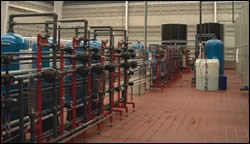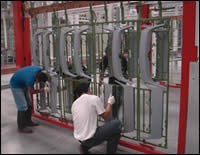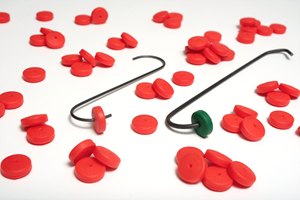Chrome Trim Gives the Jetta Some Pop
One of the world’s largest plating-on-plastics lines comes to Mexico
The Volkswagen Jetta is one of the world’s most popular passenger cars. The fifth generation of the compact sedan, redesigned and introduced in the middle of the 2005 model year, includes a front end highlighted by a large chrome grille and other decorative chrome rim pieces.
The Jetta is built exclusively in VW’s Puebla, Mexico plant. The facility has been producing cars in Puebla for more than 40 years, including Beetles for the domestic Mexican market long after the car went out of production in other parts of the world. Production at the plant currently includes the New Beetle as well as Jettas, Boras and A5s.
Volkswagen initially sourced chrome exterior trim pieces for the Jetta in Germany but faced significant logistical and cost challenges. VW de Mexico also has a policy of developing and promoting local suppliers, explains Victor Olvera, general manager of Nicro Bolta SA de CV, the Puebla company that now produces multiple chrome exterior trim components for the Jetta.
“The main reason for wanting to produce in Mexico was logistics,” Olvera says. “Our company is a joint venture between Nicro, a Mexican plating firm that’s been in business for more than 60 years; General Super Plating Inc., a U.S. company focused on plating plastic parts and Bolta, a German company that is the largest supplier of plating-on-plastics (PoP) parts in Europe. Bolta was previously supplying the Jetta trim pieces but Nicro was a supplier for VW for 25 years. We made parts for the old Beetle—all the bumpers, wheel cover, and other chrome parts.”
From the Ground Up
Established in late 2003, Nicro Bolta wasted no time in putting up a 12,000 sq m (129,000 sq ft) plant to house 200 employees involved in injection molding, plating on plastics (PoP), and related processes. For the Jetta, Nicro Bolta is a Tier II supplier that produces 12 individual injection-molded acrylonitrile butadiene-styrene (ABS) and ABS/polycarbonate (ABS/PC) parts, which are then plated with decorative bright chrome. These parts are assembled together with a fascia at Nicro Bolta’s customer before being sent to VW Puebla for assembly on the car. The components meet Volkswagen’s specification TL-528 for plated plastic parts along with other internal and German (DIN) specifications.
For the PoP operation, the company was looking for a turnkey supplier for both hardware and chemistry. Bolta recommended Atotech North America GmbH (Berlin), one of its suppliers and a company that also has operations in North America and other locations worldwide. Although other chemical and equipment suppliers were considered, none could offer process development, hardware/machine, software and chemistry from a single source. Atotech was given responsibility for designing and building the plating line, selecting the chemistries, as well as for water purification and wastewater treatment systems.
Nicro Bolta and Atotech personnel worked together to develop specifications for the line, which was engineered and fabricated in Atotech’s Feucht, Germany, facility under a very tight schedule. The contract for the line was signed in September 2004, fabrication began in late 2004, first shipments of line components to Mexico occurred in January 2005, installation began in March 2005 and production parts were rolling off the line in Puebla in July 2005. “We finished everything—including installation of the lines, the molding machines, and all equipment, in July,” Olvera recalls. “That month, we processed our first parts. I think that must be some kind of record.”
How It Works
That design and installation time may or may not be a record, but the installed system definitely is a record-setter. It’s by far the largest PoP line in Mexico and one of the largest in the world. It’s also fully automated, requiring only a few process workers up on the line, (for part racking and unracking) and a dozen engineering and maintenance personnel to monitor the process for variation and minimize weekend maintenance.
Plastic parts must be metallized before electrodeposition, and the line uses Atotech’s Noviganth chemistry to accomplish this. The process consists of etching and neutralization followed by two catalyst steps—palladium/tin and palladium activation—prior to deposition of a 0.2-μm thick layer of electroless nickel from a low-temperature alkaline process.
The EN layer is followed by a copper strike 2–5 μm thick. The now-conductive substrate then receives a 20-μm thick layer of copper produced using an acid electroplating process. This is followed by electrodeposited semi-bright nickel, high-sulfur nickel, bright, satin or micro-porous nickel and finally topped with a 0.3-μm layer of decorative chrome.
At Nicro Bolta, the modular PoP line can be quickly modified to handle different processes. When the line was configured, space was left for extra tanks to allow different processes to come on-stream quickly and with minimal disruption.
First of these will be addition of a satin finish in addition to the decorative chrome the plant produces now, according to Olvera. He visited Germany late last summer to work out details of the satin finishing process, which he says is becoming more popular with automakers around the world.
The line is a completely automated, computer-controlled hoist system. Control software is capable of identifying specific parts on the rack and adjusting immersion times and current densities to optimize production. This capability allows Nicro Bolta personnel to tailor recipes for each part to meet customer specifications without excess waste. The software also compiles historic data of each part processed with parameters during the processing for reference and lot traceability.
Average rinse tank size—the line uses multiple rinses between each process step to minimize drag-out—is 10 × 2 × 6 ft. Multi-station tanks are larger and tank construction is specific to the chemistry within each tank. One of the first process steps, for example, is etching to roughen the plastic surface of the parts. The etch tank contains a mixture of chromic and sulfuric acids and must be resistant to their strong oxidizing affects as well as to elevated temperature. It’s fabricated from polyvinylidene fluoride (PVDF). The chrome plating tank is also PVDF, while chrome-bearing rinse tanks are polyvinyl chloride (PVC). Most other process tanks are polypropylene. The nitric acid strip tank is stainless steel.
Tank bottoms are sloped for easy wash-down and elevated two ft off the floor for ease of cleaning and maintenance. All plumbing is welded polypropylene; water use is controlled by the computer system and a series of automated solenoid valves.
Process heating and cooling are done both internally and externally depending on the best application for the chemistry and maintenance. Key process tanks are equipped with three forms of agitation: air injection, mechanical flight bar movement and solution movement via pumps.
One potential issue with the process is excessive drag-out, which can render solutions ineffective. For this reason multiple rinse stages are used between each step, and the waste treatment system is sized based on specific chemistry drag-out rates.
Transporter/hoists for the line are constructed of stainless steel, titanium, polypropylene and other chemical-resistant materials. Designed to handle 1000 car sets per day of just-in-time production for the Jetta job, the line also has plenty of open capacity for future work.
According to Olvera, the line is currently running at 12 flight bars per hour, each with a capacity of 10 sq m (107.5 sq ft). A more normal load is 5 to 7 m2 (50 to 75 sq ft) per flight bar, he says. “Our current cycle time is five minutes,” he says. “But we have the capability to run with a cycle time of three minutes—20 flight bars per hour.”
Olvera says the line currently operates around the clock Monday through Thursday, with Friday reserved for maintenance. He expects to go to a five-day operation soon, with required maintenance performed on Saturdays.
Quality on the line has been excellent, Olvera says, with yields for the plated products running well over 90-95% with good quality. The startup not only eliminated VW’s logistical problems when parts were sourced from Germany, it also saved the company several euros per vehicle in cost.
Water Issues—In and Out
The plant’s water treatment system probably posed the most headaches for engineers. Well water at the site contains very high levels of dissolved and suspended solids—approximately 3,000 mg/liter—with a large amount of silica. The reverse-osmosis (RO) water pretreatment system initially spec’ed for the plant had major problems cleaning the well water before use on the plating line and in other processes, including injection molding. Water had to be trucked into the plant and placed in an underground storage tank to provide adequate quality and supply for the line until additional pre-filters and treatment processes were implemented to bring the well water up to the needed quality.
Wastewater treatment is based on specific drag-out rates of chemistries. Ion exchange is used wherever possible to recycle water. Chromium reduction is via an ORP/metabisulfite process, and dissolved solids are removed by hydroxide formation and precipitation. Discharged metal levels are equal to or below those specified in the U.S. by the Environmental Protection Agency. Sludge is collected and hauled to an approved waste site.
Related Content
Maximize Your Racking Efficiency and Quality
Best practices for racking parts in surface finishing operations.
Read MoreChicago-Based Anodizer Doubles Capacity, Enhancing Technology
Chicago Anodizing Company recently completed a major renovation, increasing its capacity for hardcoat anodizing and Type II anodizing.
Read MoreFABTECH 2024 Heads to Orlando
CCAI’s FINISHING Pavilion and Conference continues to grow at FABTECH, offering insights and innovations covering all aspects of industrial surface finishing.
Read MoreCFS Unveils New Hook Locks Parts Racking Solution
New product from Custom Fabricating & Supplies (CFS) prevents part loss during coating processes.
Read MoreRead Next
Episode 45: An Interview with Chandler Mancuso, MacDermid Envio Solutions
Chandler Mancuso, technical director with MacDermid Envio discusses updating your wastewater treatment system and implementing materials recycling solutions to increase efficiencies, control costs and reduce environmental impact.
Read MoreA ‘Clean’ Agenda Offers Unique Presentations in Chicago
The 2024 Parts Cleaning Conference, co-located with the International Manufacturing Technology Show, includes presentations by several speakers who are new to the conference and topics that have not been covered in past editions of this event.
Read MoreEducation Bringing Cleaning to Machining
Debuting new speakers and cleaning technology content during this half-day workshop co-located with IMTS 2024.
Read More

























